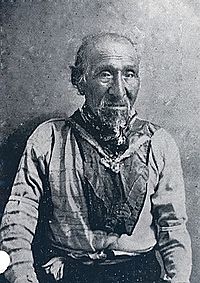Tecumtum facts for kids
Quick facts for kids
Tecumtum
|
|
|---|---|

Tecumtum (aka Chief John), ca. 1863
|
|
| Etch-Ka-Taw-Wah leader | |
| Personal details | |
| Born | Date and location unknown |
| Died | August 6, 1864 Fort Yamhill, Oregon |
| Cause of death | Old age |
| Children | At least four sons and two daughters |
| Nicknames | Chief John, Old John, Tyee John, Elk killer |
| Military service | |
| Battles/wars | Rogue River Wars |
Chief Tecumtum (died 1864) was an important leader of the Etch-ka-taw-wah people. They were a group of Athabaskan Native Americans. He played a key role in the Rogue River Wars. He also signed three agreements, called treaties, with the United States government. These treaties were made between 1851 and 1854.
Contents
About Chief Tecumtum
Tecumtum's name meant "Elk-killer." He was the chief of the Etch-ka-taw-wah people. They were one of the last groups to stop fighting in the Rogue River War. This war happened between 1855 and 1856. Tecumtum lived in Deer Creek in the Illinois Valley.
Before the war, he signed three treaties with the U.S. government. These were the Treaty with the Rogue River in 1851, 1853, and 1854. Gold was found in the area, which caused big problems. It led to a lot of tension between the Native Americans and new settlers.
Tecumtum was a main leader in the Rogue River War. He and his fighters were among the last to give up in the summer of 1856. A few years later, Tecumtum and his son were held in San Francisco. They were released in 1862 after his daughters asked for their freedom. After his release, Tecumtum moved back to Oregon. He lived on the Grand Ronde Reservation. He passed away from old age on August 6, 1864, at Fort Yamhill.
The Rogue River Wars
The discovery of gold in Southwest Oregon in 1850 changed everything. Many people moved to the area. This made the problems between Native Americans and white settlers much worse. The biggest conflicts involving Chief Tecumtum were the Rogue River Wars.
Early Conflicts
These wars started in 1851. Captain Tichenor's group killed about thirty Native Americans at Battle Rock. The main war did not fully begin until 1855. However, there were many smaller fights for years. They finally ended in 1856.
In 1855, one of Tecumtum's sons was killed. Another tribe member was also killed. After this, settlers from Jacksonville attacked a Native American village. Tecumtum and his men then went into the mountains. They fought with the white settlers for over a year.
Even during this violent time, Tecumtum still wanted peace. A government official spoke with him. Tecumtum said he would rather die fighting for his rights. He did not want his people killed for no reason.
Surrender and Relocation
In the summer of 1856, Tecumtum and his men had to surrender. They were forced to walk 125 miles. They went to a new land where they had to live. This place is now called the Siletz Reservation.
Tecumtum also took part in the Battle of Big Meadows. It is not clear if he started this battle. Some say it was a failed attempt at peace.
Cultural Differences and Tensions
Chief John, also known as Tyee John, was a Shasta chief. He tried to follow the Table Rock Treaty. Many government agents saw him as a brave and important chief. But his life was full of conflict.
Chief John lived on Deer Creek with his family. This was near the Illinois Valley. One of the first fights with white settlers happened in August 1856. Lieutenant Burrell Griffin and his soldiers attacked a Native American village. The white soldiers were outnumbered and had to leave.
Growing Conflicts
A major problem happened with gold miners. They killed Tecumtum's son and another tribe member. This made Chief John very angry. The government did not punish those who committed the crimes. Tecumtum and his people faced many attacks and unfair treatment.
Tensions grew even more. Another group, Tipsu Tyee’s band, stole things, burned property, and killed two white settlers. Because of this, miners started attacking Deer Creek in early 1854. The Shasta warriors led their people into the forest to hide.
The Fight for Land
The white settlers became stronger when the California Volunteer Militia joined the war. Colonel Buchanan and Captain Andrew Smith fought against the Shasta leader in the Rogue River War.
In 1856, Tecumtum spoke to Colonel Buchanan. He said, "You are a great chief. So am I. This is my country; I was in it when those trees were very small, not higher than my head. My heart is sick with fighting, but I want to live in my country. If the white people are willing, I will go back to the Deer creek and live among them as I used to do. They can visit my camp, and I will visit theirs; but I will not lay down my arms and go with you on the reserve. I will fight. Good-by."
In the end, more than half of the Rogue Tribe was moved. They were sent to the Coast Reservation, managed by the Siletz Agency.
Images for kids


